Related Research Articles
Hesse is a locality in the Golden Plains Shire, Victoria, Australia. In the 2016 census, Hesse had a population of 19 people.
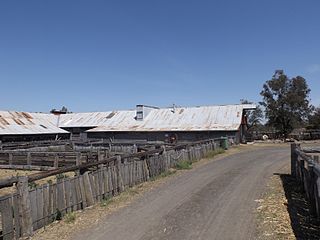
Jondaryan Woolshed is a heritage-listed shearing shed at Evanslea Road, Jondaryan, Queensland, Australia. It was built in 1859-60 to replace an earlier, smaller woolshed on the former Jondaryan pastoral station, which was at one stage the largest freehold station in Queensland. The woolshed was the scene of significant labour conflict in the late 1880s and early 1890s, as the station became a test case for the new Queensland Shearers Union in the lead-up to the 1891 Australian shearers' strike.

Saumarez Homestead is a heritage-listed homestead located at 230 Saumarez Road, Armidale in the Armidale Regional Council local government area of New South Wales, Australia. The homestead was designed by J. W. Pender in the Federation Edwardian style and built between 1888 and 1906 by H. E. Elliott, while the garden was established by Mary White. The property is currently owned by the National Trust of Australia (NSW), who operate it as a museum and function venue. The homestead was added to the New South Wales State Heritage Register on 1 March 2002.

Nindooinbah Homestead is a heritage-listed homestead at Nindooinbah Connection Road, Nindooinbah, Scenic Rim Region, Queensland, Australia. It was built from c. 1858 to 1907. It is also known as Nindooinbah House. It was added to the Queensland Heritage Register on 21 October 1992.

Franklyn Vale Homestead is a heritage-listed homestead at Franklin Vale Road, Mount Mort, City of Ipswich, Queensland, Australia. It was built in the early 1870s. It was added to the Queensland Heritage Register on 21 October 1992.
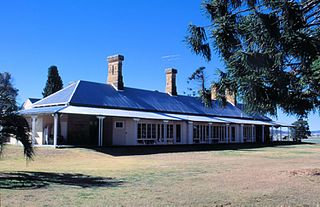
Talgai Homestead is a heritage-listed homestead at Allora, Southern Downs Region, Queensland, Australia. It was designed by architect Richard George Suter for Queensland pastoralist and politician George Clark and was built in 1868. It was added to the Queensland Heritage Register on 21 August 1992. It is also known as East Talgai Homestead to distinguish it from the West Talgai Homestead built by Clark's brother, Charles Clark. The homestead is now a private residence, owned by the Nioa family.

Glengallan Homestead is a heritage-listed homestead on the New England Highway, Glengallan, Southern Downs Region, Queensland, Australia. It was built from 1864 to 1904. It is also known as Glengallan Head Station. It was added to the Queensland Heritage Register on 21 October 1992 and is open to the public.
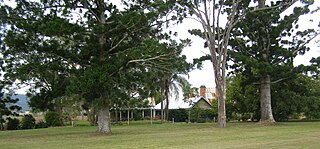
Cressbrook Homestead is a heritage-listed homestead at off Cressbrook-Caboombah Road, Cressbrook, Somerset Region, Queensland, Australia. It was built from 1841 to 1914. It was added to the Queensland Heritage Register on 21 October 1992.

Burrandowan Station Homestead is a heritage-listed homestead at Kingaroy Road, Durong, South Burnett Region, Queensland, Australia. It was built from 1848 to c. 1927. It was added to the Queensland Heritage Register on 21 October 1992.

The Glebe Homestead is a heritage-listed homestead at Taroom-Cracow Road, Glebe near Taroom, Shire of Banana, Queensland, Australia. It was designed by Florence Mary Rigby and built c. 1920. It is also known as Broadwater. It was added to the Queensland Heritage Register on 23 March 2007.
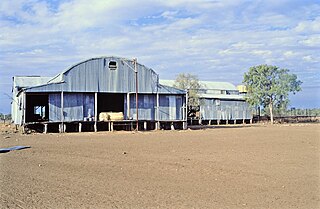
Darr River Downs is a heritage-listed homestead at Landsborough Highway, Morella, Longreach Region, Queensland, Australia. It was built from 1870s circa to 1900s circa. It was added to the Queensland Heritage Register on 27 June 2003.
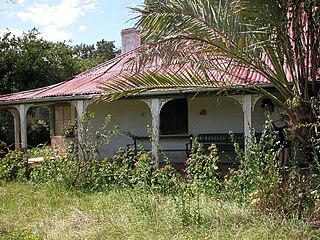
Cliefden is a heritage-listed homestead at 1521 Belubula Way, Mandurama, in the Central West region of New South Wales, Australia. It is one of a group of historic sites labelled the Ben Hall Sites for their association with bushranger Ben Hall, along with Ben Hall's Death Site, the Bushranger Hotel, Escort Rock, the Grave of Ben Hall and Wandi. It was built from 1842. It was added to the New South Wales State Heritage Register on 8 October 2010.
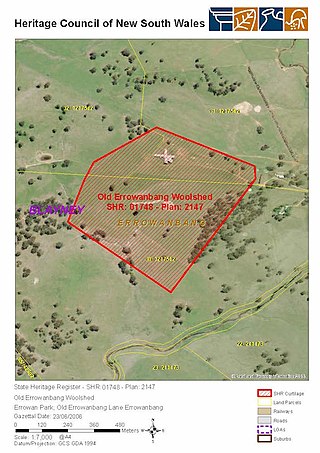
Old Errowanbang Woolshed is a heritage-listed shearing shed at Errowan Park, Old Errowanbang Lane, Errowanbang, Blayney Shire, New South Wales, Australia. It was designed by Watt and built in 1886. It is also known as Errowanbang Woolshed. It was added to the New South Wales State Heritage Register on 23 June 2006.

Savernake Station is a heritage-listed working farm located at 2341 Mulwala Road, Savernake, Federation Council, New South Wales, Australia. It was designed and built from 1862. It is also known as Savernake Homestead. It was added to the New South Wales State Heritage Register on 15 March 2013. The heritage listing includes the station's moveable heritage, including significant collections and archives relating to the property.

Bella Vista is a heritage-listed residence at Elizabeth Macarthur Drive, Bella Vista, The Hills Shire, New South Wales, Australia. It was built from 1830 to 1960. It is also known as Kings Langley, Stock Farm, Seven Hills Farm and Bella Vista Farm. The property is owned by The Hills Shire Council and was added to the New South Wales State Heritage Register on 2 April 1999.
Golden Vale is a heritage-listed farm and country residence at Golden Vale Road, Sutton Forest, Wingecarribee Shire, New South Wales, Australia. It was built from 1868 to 1869. It is also known as Golden Valley. The property is owned by the National Trust of Australia (NSW). It was added to the New South Wales State Heritage Register on 2 April 1999.
Mulwala Homestead is a heritage-listed homestead at North Road, Mulwala, New South Wales, Australia. It was added to the Australian Commonwealth Heritage List on 22 June 2004.
The Newnham campus of the Australian Maritime College is a heritage-listed university campus at 100 Newnham Drive, Newnham, Tasmania, Australia. It was formerly a prominent pastoral estate known as Newnham Estate. It was added to the Australian Commonwealth Heritage List on 22 June 2004.
East Warrah Woolshed is a heritage-listed shearing shed at Merriwa-Murrurundi Road, Warrah Creek, Liverpool Plains Shire, New South Wales, Australia. It was designed by Samuel Craik and built from 1863 to 1864. It was added to the New South Wales State Heritage Register on 10 August 2018.
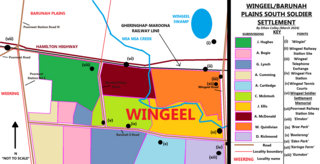
Wingeel is a locality in Victoria, Australia. The locality straddles both the Colac Otway Shire and the Golden Plains Shire, the former containing the largest portion. In the 2021 census, Wingeel had a population of 26.
References
- 1 2 3 4 5 6 7 8 9 10 11 "Barwon Sewer Aqueduct, Leather St, Breakwater, VIC, Australia". Australian Heritage Database. Department of the Environment. Retrieved 25 November 2014.
- ↑ "Schedule to the Heritage Overlay" (PDF). Shire of Golden Plains Planning Scheme. Department of Transport, Planning and Local Infrastructure. 18 July 2013. Retrieved 13 July 2014.
- ↑ "Barunah Plains Homestead & Garden". National Trust of Australia Classification. Heritage Victoria . Retrieved 13 July 2014.
- ↑ "Barunah Plains Homestead Outbuildings and Garden". Golden Plains Shire Heritage Overlay. Heritage Victoria . Retrieved 13 July 2014.
- ↑ Gadd, Gemma (14 November 2012). "Historic homestead on a rolling plain". The Weekly Times.
- ↑ "Masters of their craft". The Weekly Times. 11 October 2000.
- 1 2 Betley, Graham (14 November 1998). "Homestead for tourists". The Age.
- 1 2 Rindfleisch, Tony (5 April 1998). "Barunah Plains - when the sheep was king". Herald Sun.
- ↑ Moloney, Brendan (9 February 1998). "The best golf clubhouses in Australia". BRW.
- ↑ Pinder, Simon (4 November 1998). "Revival on course". The Weekly Times.
- ↑ "Buyer nabs a slice of history". The Weekly Times. 31 March 1999.
- ↑ Aprhys, Alison (8 December 2012). "House sale reaches new heights". Geelong Advertiser.
Attribution
![]() This article incorporates text available under the CC BY 3.0 AU licence.Required attribution: © Commonwealth of Australia 2013.
This article incorporates text available under the CC BY 3.0 AU licence.Required attribution: © Commonwealth of Australia 2013.